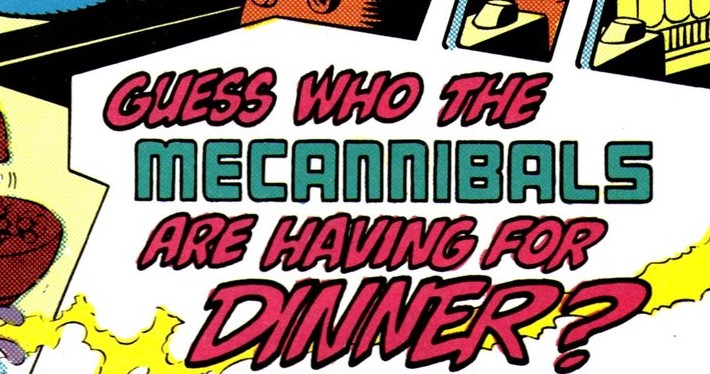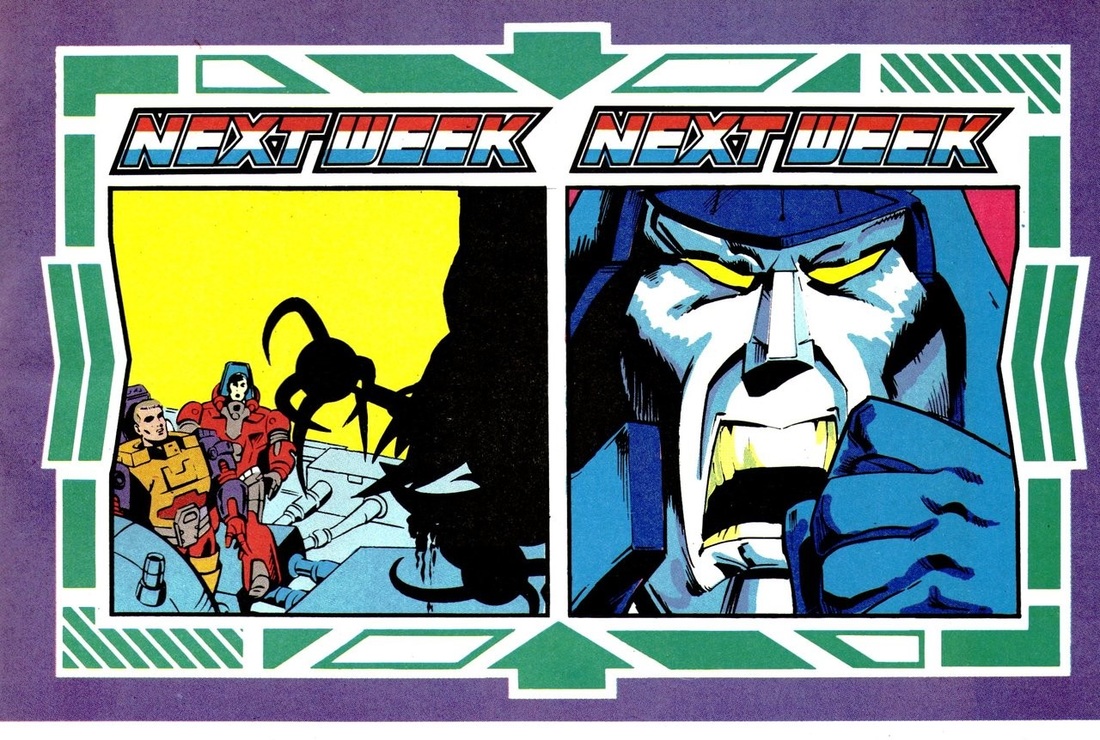Two is Enough That's What They'll Say, But We'll Say Hell No, One-Two-Three Way.
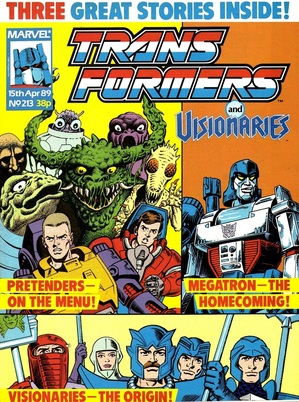
Issue 213: Guess Who the Mechannibals are Having for Dinner? Part 1/The Fall and Rise of the Decepticon Empire Part 1. 8th April 1989.
Please, show your appreciation for our cause’s most celebrated loony!
All change. I mentioned during the previous story that the weight of the format change somewhat overwhelmed it, and that’s even more true here. For UK readers the two new stories are often overlooked entirely amidst discussion of the format shift, the redesign, the fears for the future and the outright lies the book presents. I’m going to start by focusing on the actual fiction rather than the nitty gritty of the behind the scenes machinations, but it’s almost impossible to not cover the wider picture at every stage because every decision about this book-saving relaunch is going to affect what we read.
This is evident right from the start of our lead (once the format settles down the comic will treat the UK story as the main one, but considering the American is first and in colour it’s hard for it not to feel the more important) strip, the latest in Bob Budiansky’s “Am I still here?” victory lap tour. From now on each American issue is going to be cut into four parts. Though I mentioned how this is going to affect the pacing last week it makes a degree of sense as having an American adventure in every issue means they need to be paced at a monthly rate so as not to overtake the parent book. This strategy is entirely based on the American issues being long enough to split into four consistently and the release schedule not briefly shifting to bimonthly for logistical reasons. This will not be the case and will create some special problems later in the year.
Please, show your appreciation for our cause’s most celebrated loony!
All change. I mentioned during the previous story that the weight of the format change somewhat overwhelmed it, and that’s even more true here. For UK readers the two new stories are often overlooked entirely amidst discussion of the format shift, the redesign, the fears for the future and the outright lies the book presents. I’m going to start by focusing on the actual fiction rather than the nitty gritty of the behind the scenes machinations, but it’s almost impossible to not cover the wider picture at every stage because every decision about this book-saving relaunch is going to affect what we read.
This is evident right from the start of our lead (once the format settles down the comic will treat the UK story as the main one, but considering the American is first and in colour it’s hard for it not to feel the more important) strip, the latest in Bob Budiansky’s “Am I still here?” victory lap tour. From now on each American issue is going to be cut into four parts. Though I mentioned how this is going to affect the pacing last week it makes a degree of sense as having an American adventure in every issue means they need to be paced at a monthly rate so as not to overtake the parent book. This strategy is entirely based on the American issues being long enough to split into four consistently and the release schedule not briefly shifting to bimonthly for logistical reasons. This will not be the case and will create some special problems later in the year.
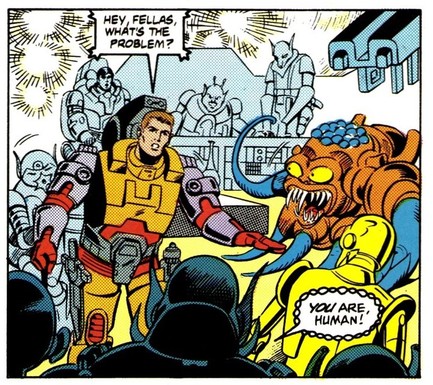 "This probably isn't the droid you're looking for"
"This probably isn't the droid you're looking for"
Guess Who the Mechannibals are Having for Dinner? will manage the full four parts and sees Uncle Bob move back into the space opera field he toyed with in 1988 in stories like The Cosmic Carnival! Indeed, it even opens with a Star Wars cantina scene homage. It’s worth noting that 1989 was roughly speaking the point where the popularity of Star Wars was at its lowest and the franchise looked to be fading into history. Budiansky’s finger is well off the pulse of contemporary popular culture here, and it’s odd to see it done—complete with C3PO looking droid--12 years after everyone else had ripped it off.
The reason for this visit to the Black Hole Bar and Grill on the disreputable Grand Central station is actually a sensible one as we’ll see. But for now we’re confronted with an alien bartender telling C3PNOT they don’t serve his kind in here. Thankfully he doesn’t go as far as shouting “No disintegrations!”, but the effect is still to annoy the watching Cloudburst and Landmine.
The robophobia of the locals (though they don’t like humans—and I’m going to assume we’re talking an abbreviation of “Humanoid” here to stay sane—much either) makes sense of sending two Pretenders on this mission, indeed if there’s great hatred of robots generally in the galaxy perhaps it explains why Primus built his babies to transform into disguises as well. It certainly suggests a more considered approach than might be expected from Bob at this point.
But there’s a massive problem here in that Cloudburst and Landmine are comfortably the dullest lead characters Budiansky ever wrote for the book. They look dull, they have virtually identical (one is a bit more headstrong than the other) dull personalities and there’s nothing to make the readers engage or have interest in them. And they’re going to not just be the lead characters but almost the only Autobots in the first strip for two months solid. Amidst all the other problems the book is having at the moment this is not one it needed.
The reason for this visit to the Black Hole Bar and Grill on the disreputable Grand Central station is actually a sensible one as we’ll see. But for now we’re confronted with an alien bartender telling C3PNOT they don’t serve his kind in here. Thankfully he doesn’t go as far as shouting “No disintegrations!”, but the effect is still to annoy the watching Cloudburst and Landmine.
The robophobia of the locals (though they don’t like humans—and I’m going to assume we’re talking an abbreviation of “Humanoid” here to stay sane—much either) makes sense of sending two Pretenders on this mission, indeed if there’s great hatred of robots generally in the galaxy perhaps it explains why Primus built his babies to transform into disguises as well. It certainly suggests a more considered approach than might be expected from Bob at this point.
But there’s a massive problem here in that Cloudburst and Landmine are comfortably the dullest lead characters Budiansky ever wrote for the book. They look dull, they have virtually identical (one is a bit more headstrong than the other) dull personalities and there’s nothing to make the readers engage or have interest in them. And they’re going to not just be the lead characters but almost the only Autobots in the first strip for two months solid. Amidst all the other problems the book is having at the moment this is not one it needed.
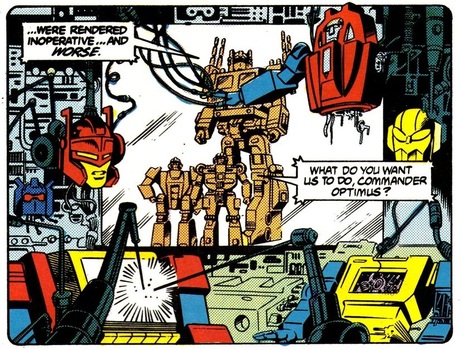 "Oh Gears!"
"Oh Gears!"
The two do try and help the bullied droid, though in a half arsed way as after they’ve failed and he’s been thrown out into space they show no interest in assisting him further. Them just watching him float past the window with complete apathy is unintentionally hilarious. The main plot beat beyond this is seeing two hooded “Humans” wearing what looks exactly like Hi-Test and Throttle’s costumes leave the bar. Who could they possibly be?
The last page of this truncated adventure is a flashback explaining the reason for their mission. Back on the Ark Optimus helps Budiansky back-pedal on the damage done during Dark Star by explaining to the two Pretenders that many of their troops can be repaired if they get enough microchips, as can be found on black market on the space station. It’s a sensible reason and it’s actually nice that Budiansky goes for something as simple as “Microchips” rather than coming up with a fancy sci-fi term. However, seeing the broken up bodies of Blaster and Goldbug (and even friend of Spider-Man Gears) just reminds you of what a proper Transformers character is like and makes the ending of our two heroes—riding in Cloudburst’s spaceship mode, mass shifting!—going off on their adventure very foreboding.
This doesn’t really have a chance to get going, but the highlight is very much Delbo’s art for once. He’s having a ball with the obligatory weird aliens and the one panel of headless Autobot corpses is extremely grisly. Otherwise though it’s not really the big statement of intent the new look needed to reassure people.
The last page of this truncated adventure is a flashback explaining the reason for their mission. Back on the Ark Optimus helps Budiansky back-pedal on the damage done during Dark Star by explaining to the two Pretenders that many of their troops can be repaired if they get enough microchips, as can be found on black market on the space station. It’s a sensible reason and it’s actually nice that Budiansky goes for something as simple as “Microchips” rather than coming up with a fancy sci-fi term. However, seeing the broken up bodies of Blaster and Goldbug (and even friend of Spider-Man Gears) just reminds you of what a proper Transformers character is like and makes the ending of our two heroes—riding in Cloudburst’s spaceship mode, mass shifting!—going off on their adventure very foreboding.
This doesn’t really have a chance to get going, but the highlight is very much Delbo’s art for once. He’s having a ball with the obligatory weird aliens and the one panel of headless Autobot corpses is extremely grisly. Otherwise though it’s not really the big statement of intent the new look needed to reassure people.
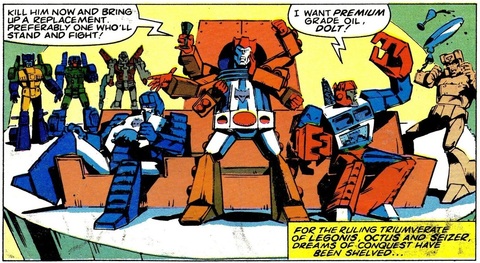 The new judging panel for The Voice surprised everyone.
The new judging panel for The Voice surprised everyone.
The second story however, is an overlooked classic. It helps here that Furman actually was trying to kick off a new direction, though it’s one that will get lost as the conflict between his British and American stories reaches crisis point. Indeed, it’s worth remembering that his first American story was published only a month after this, he’d have been at least well into plotting it at the time he was writing this take on Megatron, which makes it all the odder, which is something we’ll get into more next week.
Yes, The Fall and Rise of the Decepticon Empire (as the page count for each story gets lower the titles get longer) picks up on the character development for Megatron during Time Wars by bringing him home. A see issue box points out the last time he was back home was issue 98, and Furman cleverly makes this a parallel for Optimus' distraught return to Cybertron there.
Whilst Prime was broken by the site of a ruined Iacon, here Megatron finds the Decepticon capital city of Helex to be tremendously nice. Autobots walk the streets happily and unmolested and there isn’t a single smelting pool to be seen. Megatron’s rage is entertaining, but the fact he’s so angry before he knows all the facts emphasises the self control issues and tendency towards red mist the rest of this story will address. This opening is full of lovely details in both art and story. The opening splash has a focus on Megatron thwacking an Autobot head-first into a wall, but wonderfully Ravage is also casually ripping apart an Autobot on the bottom left. This sets up that this is going to be a surprisingly brutal story, even by the standards of this series. But that’s appropriate for something with a title that evokes the fall of decadent Rome.
Equally nice is the character beat given to the nameless orange (there’s a lot of orange here) Autobot, shocked and desperate at the sight of the return of Megatron he gets an inner monologue to himself as he tries to raise his gun and take aim...and Ravage barely gets a warning out before Megatron simply takes him out. Killing and then casually strolling off without even breaking a sweat to sort out the Decepticons is one of the coolest—and coldest—moments in the entire series.
Over at the Decepticon Power Base (not as good a name as Fortress Sinister) we’re introduced to the current Decepticon leadership on at least this part of the planet (later events will make it clear the situation has fractured since Ratbat went to Earth a year ago) and the explanation for the new relaxed Cybertron. They are now ruled by the Triumverate, three new comic only Decepticons with vaguely faux-Latin names so as to keep up with the theme of the title. Legonis, Octus and Seizer (who is basically an orange Scorponok) are all well designed nasty looking bruisers, but of course it’s Octus who has gone on to be the best known of them.
Yes, The Fall and Rise of the Decepticon Empire (as the page count for each story gets lower the titles get longer) picks up on the character development for Megatron during Time Wars by bringing him home. A see issue box points out the last time he was back home was issue 98, and Furman cleverly makes this a parallel for Optimus' distraught return to Cybertron there.
Whilst Prime was broken by the site of a ruined Iacon, here Megatron finds the Decepticon capital city of Helex to be tremendously nice. Autobots walk the streets happily and unmolested and there isn’t a single smelting pool to be seen. Megatron’s rage is entertaining, but the fact he’s so angry before he knows all the facts emphasises the self control issues and tendency towards red mist the rest of this story will address. This opening is full of lovely details in both art and story. The opening splash has a focus on Megatron thwacking an Autobot head-first into a wall, but wonderfully Ravage is also casually ripping apart an Autobot on the bottom left. This sets up that this is going to be a surprisingly brutal story, even by the standards of this series. But that’s appropriate for something with a title that evokes the fall of decadent Rome.
Equally nice is the character beat given to the nameless orange (there’s a lot of orange here) Autobot, shocked and desperate at the sight of the return of Megatron he gets an inner monologue to himself as he tries to raise his gun and take aim...and Ravage barely gets a warning out before Megatron simply takes him out. Killing and then casually strolling off without even breaking a sweat to sort out the Decepticons is one of the coolest—and coldest—moments in the entire series.
Over at the Decepticon Power Base (not as good a name as Fortress Sinister) we’re introduced to the current Decepticon leadership on at least this part of the planet (later events will make it clear the situation has fractured since Ratbat went to Earth a year ago) and the explanation for the new relaxed Cybertron. They are now ruled by the Triumverate, three new comic only Decepticons with vaguely faux-Latin names so as to keep up with the theme of the title. Legonis, Octus and Seizer (who is basically an orange Scorponok) are all well designed nasty looking bruisers, but of course it’s Octus who has gone on to be the best known of them.
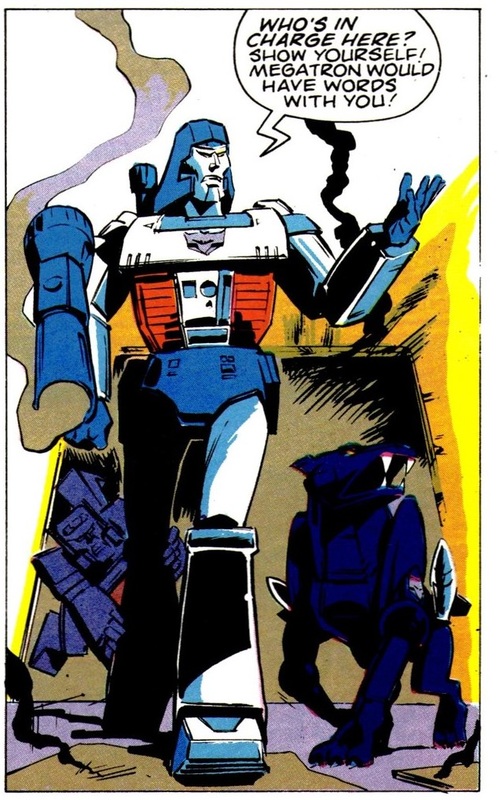 "I said you couldn't come in here!"
"I said you couldn't come in here!"
This is simply because the eight-limbed Octus turns into a Dalek (albeit an orange one). It’s obvious even with Lee Sullivan being asked to remove the eye stalk by editorial in case the Terry Nation estate was watching (he told me this when drawing me an Octus sketch that was more based on what he originally wanted. Top man Lee Sullivan) and has turned the character into an interesting bit of trivia. Octus even gets a mention in the Doctor Who Who-Ology book written by Carven Scott and Mark Wright (which might mean two more Big Finish writers who are fans of the comic. They’re practically running that company) and most recently even got to cameo in an issue of More Than Meets the Eye. Despite only appearing in this one very short two parter he’s effectively the third most famous UK created Transformer after Impactor and Xaaron.
Octus and his less famous friends have effectively built their power upon the bread and circuses principal—no more fighting of war but instead endless entertainment provided by gladiatorial matches between their troops and the vast supply of Autobot prisoners. It’s an idea Last Stand of the Wreckers will revisit and the casual brutality of Quake axing a fallen combatant whilst a casual conversation is going on between the three leaders makes for a nice contrast.
Behind them the Triggercons (in their first present day appearance) are increasingly frustrated and angry at the loss of the old ways, especially when the idea of setting Decepticon against Decepticon is mooted as a way of dealing with things when the prisoners run out rather than going to grab some new ones. They want a return to going out and fighting and killing Autobots, not this slow death from decadence.
This is one of the cleverer things the story does, firmly putting the reader on the side of the villains who want to go out and kill people. The Decepticons in the crowd seem happy and the war is effectively over, but it would make for a very dull book so we are effectively complicit in wanting galactic war to start up again for our own entertainment just as the gladiatorial games are such for those in the comic.
Luckily just the man for the job arrives as Megatron blasts his way in through a door and casually walks into the arena with a bouncer desperately hanging on to his leg whilst asking to speak to whoever is in charge. It’s an amazing, funny bit of art that fully makes Megatron the hero of this story.
Sadly things have to end there before we get into some interesting parallels with how Megatron is written in the aforementioned current More Than Meets the Eye, but at least we close on Octus calling Megatron a “Loony” in front of the crowd as he works to stop Megatron’s berating of the gathered troops swaying anyone.
This was of course intended to be just one eleven page story, a light bridging adventure on the way to bigger things. However, it survives the transition much better than the opening story and is an exiting, thoughtful read that speaks of a lost great era that should have followed it. The only reason this is in colour is that the art had already been paid for, which is ironic as of three artists caught in this strange transition period who expected their art to be in colour (the others being Andy Wildman and Dan Reed), it’s Lee Sullivan who would have coped best with their work unexpectedly being monochrome. Indeed, it might have been a relief from how orange everything is, sadly Stuart Place does not do a very good job on the final original colour story.
Hell, the three villains even feel designed to work as a commentary on the new format despite that very much not being the case!
Octus and his less famous friends have effectively built their power upon the bread and circuses principal—no more fighting of war but instead endless entertainment provided by gladiatorial matches between their troops and the vast supply of Autobot prisoners. It’s an idea Last Stand of the Wreckers will revisit and the casual brutality of Quake axing a fallen combatant whilst a casual conversation is going on between the three leaders makes for a nice contrast.
Behind them the Triggercons (in their first present day appearance) are increasingly frustrated and angry at the loss of the old ways, especially when the idea of setting Decepticon against Decepticon is mooted as a way of dealing with things when the prisoners run out rather than going to grab some new ones. They want a return to going out and fighting and killing Autobots, not this slow death from decadence.
This is one of the cleverer things the story does, firmly putting the reader on the side of the villains who want to go out and kill people. The Decepticons in the crowd seem happy and the war is effectively over, but it would make for a very dull book so we are effectively complicit in wanting galactic war to start up again for our own entertainment just as the gladiatorial games are such for those in the comic.
Luckily just the man for the job arrives as Megatron blasts his way in through a door and casually walks into the arena with a bouncer desperately hanging on to his leg whilst asking to speak to whoever is in charge. It’s an amazing, funny bit of art that fully makes Megatron the hero of this story.
Sadly things have to end there before we get into some interesting parallels with how Megatron is written in the aforementioned current More Than Meets the Eye, but at least we close on Octus calling Megatron a “Loony” in front of the crowd as he works to stop Megatron’s berating of the gathered troops swaying anyone.
This was of course intended to be just one eleven page story, a light bridging adventure on the way to bigger things. However, it survives the transition much better than the opening story and is an exiting, thoughtful read that speaks of a lost great era that should have followed it. The only reason this is in colour is that the art had already been paid for, which is ironic as of three artists caught in this strange transition period who expected their art to be in colour (the others being Andy Wildman and Dan Reed), it’s Lee Sullivan who would have coped best with their work unexpectedly being monochrome. Indeed, it might have been a relief from how orange everything is, sadly Stuart Place does not do a very good job on the final original colour story.
Hell, the three villains even feel designed to work as a commentary on the new format despite that very much not being the case!
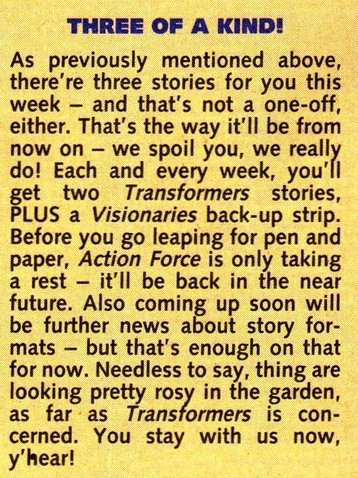 I think they're overestimating how worried we are about Action Force.
I think they're overestimating how worried we are about Action Force.
The most striking thing about the cover is how it tries to sell the three story format as a plus. John Stokes tries his best but it’s a crowded muddle seemingly drawn without visual reference (the monsters surrounding the Pretenders aren’t in the bar and the other two stories are represented by head shots) and it’s easy to see why this approach won’t last. Considering how late in the day the shift it’s probable there’s a specific Fall and Rise... cover out there somewhere in the either that I suspect looks much better.
Inside and it’s notable that, updated logo aside, the Transformation page has returned to its pre-Space Pirates! layout, which is a sensible move (the Autobrand on the “NEXT” strap-line has been updated as well). The page itself is an annoying read though. I accept the new format was a desperate attempt to stave of cancellation and we owe it the book continuing as long as it does, but it’s sold in an underhanded way.
First up, we have a three pence price raise to 38p that is only mentioned right at the end and in a completely unapologetic way (“It’s still got to be great value for money, eh?!), previously the comic has tended to give advance notice of this and usually explain them in terms of sad but unavoidable rising costs. Equally, the forthcoming switch to being partly black and white that will make the price rise feel even worse is only alluded to in the promise of “Further news about story formats”. Again, forewarning and a fairly honest cost based apology would have worked much better than denial. Instead there’s the oddly forced “Needless to say things are looking pretty rosy in the garden, as far as Transformers is concerned. You stay with us now, y’hear!”. You’ll have also noticed the writing style is trying too hard to be casual and down with the kids now. Certainly as a means of selling a difficult transition, it’s a failure.
Dreadwind meanwhile has had a make over, with a new purple look and shrunken abstract logo. To coincide with this I’m going to start a new section called Dreadwind Fails to Answer Questions Properly!
Inside and it’s notable that, updated logo aside, the Transformation page has returned to its pre-Space Pirates! layout, which is a sensible move (the Autobrand on the “NEXT” strap-line has been updated as well). The page itself is an annoying read though. I accept the new format was a desperate attempt to stave of cancellation and we owe it the book continuing as long as it does, but it’s sold in an underhanded way.
First up, we have a three pence price raise to 38p that is only mentioned right at the end and in a completely unapologetic way (“It’s still got to be great value for money, eh?!), previously the comic has tended to give advance notice of this and usually explain them in terms of sad but unavoidable rising costs. Equally, the forthcoming switch to being partly black and white that will make the price rise feel even worse is only alluded to in the promise of “Further news about story formats”. Again, forewarning and a fairly honest cost based apology would have worked much better than denial. Instead there’s the oddly forced “Needless to say things are looking pretty rosy in the garden, as far as Transformers is concerned. You stay with us now, y’hear!”. You’ll have also noticed the writing style is trying too hard to be casual and down with the kids now. Certainly as a means of selling a difficult transition, it’s a failure.
Dreadwind meanwhile has had a make over, with a new purple look and shrunken abstract logo. To coincide with this I’m going to start a new section called Dreadwind Fails to Answer Questions Properly!
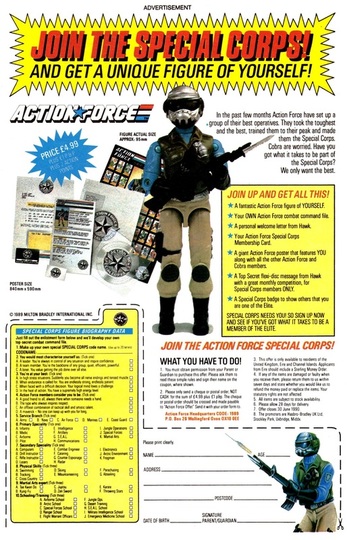 I yearned for this so badly.
I yearned for this so badly.
This week on Dreadwind Fails to Answer Questions Properly!: Dreadwind fails to answer Daniel Hodgson from Norwich’s three questions properly. In reverse order how much of a failure the three answers are: When are we going to see Unicron again? (Dreadwind’s answer: You never know hume); Why did Rodimus claim Optimus gave him the Matrix when it was handed to Ultra Magnus first (Dreadwind’s answer: Maybe Ultra Magnus gave it back?) and how come Fortress Maximus is the same size as Rodimus Prime when he was so much larger in Transformers: The Movie (Dreadwind’s answer: It’s called artistic licence hume, look it up). This is in reply to a child who is young enough to have confused the film with Rebirth.
The third of our exiting strips is Visionaries issue one The End--again. Despite what the cover promises this opening of the adaptation of the cartoon pilot doesn’t actually have any Visionaries in it and instead is about Merklynn the magician being a dick in a flying restaurant as the age of science ends. It’s still quite fun though.
AtoZ covers Mirage and Mixmaster whilst Combat Colin and Semi-Automatic Steve ruin their double date with the Giggly sisters after Steve tries kill a fly with a mini nuclear sub.
Most exciting thing of all the secondary material this week though is to do with Action Force. The club has been revamped as the Special Corps and by joining you can get a toy of...yourself! Yes, the masked figure will come with your own personally picked codename and a back-story based on a series of ticked off options on the form (such as what his skills are), how awesome is that? It’s a shame there isn’t a female option—though the form is actually careful not to refer to the toy by gender it’s obviously a bloke—especially considering the larger number of stronger female characters likely meant Joe had more girl fans than was typical for a boys toy franchise. Still, I was ridiculously obsessed with the idea of this as a kid despite not even liking the Forcies.
Speaking of unknown mystery figures, Euan Peters is actually pretty much a mystery, especially with regards to where he is now. Friend of the site James Roberts is keen to track him down for an interview for the Classics UK books so if you know Euan Peters do let him know that if he fancies talking about his time on the series he can either contact me ([email protected] or @InflatableDalek on twitter) or holler at James himself @jroberts332.
It’s a long shot at this stage, but you never know.
Also, don’t forget the chance for you to be on the 20th anniversary TFArchive podcast HERE.
Next week...well perhaps in honour of the new Next Week (and in keeping with the hurried nature of the format change, it has an image from this issue representing Fall and Rise… whilst the Transformation page uses one from next week) page in the comic I should leave this bit without any text.
ISSUE 212
1989
COMMENT
